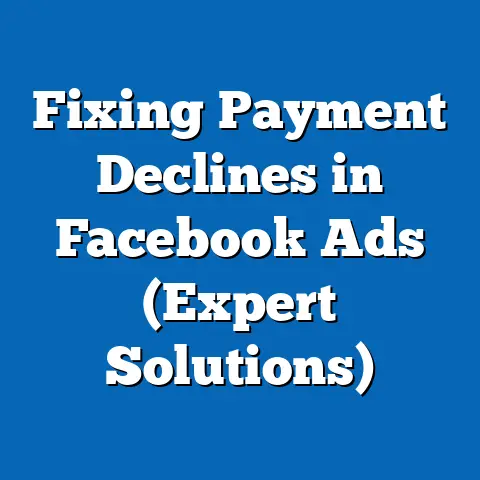Stop Facebook Ad Scams Today (Essential Prevention Tips)
Isn’t it funny how we trust a cute cat video more than a Facebook ad promising to double our money overnight? Perhaps it’s because we’ve seen more ‘pawsitive’ outcomes from felines than from those flashy ads! In today’s digital age, Facebook has become a bustling marketplace, connecting billions of people across the globe. But with great reach comes great responsibility… and, unfortunately, great opportunity for scammers. Facebook ad scams are rampant, lurking in the shadows of legitimate businesses, ready to pounce on unsuspecting users.
As someone who’s spent years navigating the digital marketing landscape, I’ve seen firsthand the devastating impact these scams can have on individuals and businesses alike. It’s not just about losing money; it’s about the breach of trust, the feeling of violation, and the potential for identity theft. That’s why it’s crucial to be vigilant and educated about these online threats. In this guide, I’ll walk you through the murky world of Facebook ad scams, providing you with the knowledge and tools you need to protect yourself and your loved ones from falling victim.
We’ll delve into how these scams operate, the red flags to watch out for, and, most importantly, the essential prevention tips that can keep you safe. Because let’s face it, a little bit of skepticism can go a long way in the wild west of the internet.
Understanding Facebook Ads and Scams
Facebook ads are a powerful tool for businesses to reach their target audiences. They’re the digital billboards of the 21st century, strategically placed in your newsfeed, vying for your attention. But what exactly are they, and how do they function within the advertising ecosystem?
What are Facebook Ads?
Facebook ads are paid messages that businesses create and display on Facebook’s platform. These ads can take various forms, including images, videos, carousels, and lead forms. They’re designed to promote products, services, events, or even just to raise brand awareness. What makes Facebook ads so effective is their precise targeting capabilities. Businesses can target users based on demographics, interests, behaviors, and even their connections, ensuring that their message reaches the right people.
Defining Scams in the Context of Facebook Ads
A scam, in the context of Facebook ads, refers to any deceptive or fraudulent advertisement designed to trick users into parting with their money or personal information. These ads often masquerade as legitimate offers, but their true intent is to exploit and deceive. Scammers leverage the trust people place in the Facebook platform to carry out their malicious activities.
Common Types of Facebook Ad Scams
Over the years, I’ve seen countless variations of Facebook ad scams, but some of the most common include:
- Phishing Scams: These ads lure users to fake websites that mimic legitimate businesses, such as banks or online retailers. The goal is to trick users into entering their login credentials or financial information, which the scammers then steal.
- Counterfeit Product Scams: These ads promote fake or low-quality products that are often sold at a steep discount. Users who purchase these products receive either nothing at all or a cheap imitation of what they were promised.
- Investment Scams: These ads promise unrealistic returns on investments, often involving cryptocurrency or other high-risk ventures. Scammers use high-pressure tactics to convince users to invest their money, which they then disappear with.
- “Get Rich Quick” Schemes: These ads promote dubious business opportunities or schemes that promise easy money with little effort. Users are often required to pay an upfront fee or purchase a training program, which turns out to be worthless.
- Fake Sweepstakes and Contests: These ads entice users to enter fake sweepstakes or contests, often requiring them to provide personal information or click on malicious links.
The Alarming Rise of Facebook Ad Scams
The prevalence of Facebook ad scams is a growing concern. According to recent reports, the number of reported scams on social media platforms, including Facebook, has skyrocketed in recent years. The Federal Trade Commission (FTC) has reported that consumers lost billions of dollars to fraud originating on social media platforms, with Facebook being a significant source of these scams.
I remember a conversation I had with a small business owner who had their brand impersonated in a Facebook ad scam. The scammers created a fake page that looked almost identical to the real one and ran ads offering deep discounts on their products. Customers who fell for the scam ended up receiving nothing, and the business owner had to deal with the fallout of angry customers and a damaged reputation. It was a stark reminder of how easily scammers can exploit the platform and the devastating consequences that can follow.
The rise of these scams is fueled by several factors, including the increasing sophistication of scam tactics, the anonymity of the internet, and the sheer scale of Facebook’s user base. It’s a constant cat-and-mouse game, with scammers continually evolving their methods to evade detection. That’s why it’s essential to stay informed and proactive in protecting yourself.
How Facebook Ad Scams Operate
Understanding how Facebook ad scams operate is crucial to protecting yourself. Scammers are constantly refining their tactics, but their underlying strategies often rely on exploiting human psychology and leveraging the platform’s features to their advantage.
Tactics Used by Scammers
Scammers employ a variety of tactics to lure victims, often playing on emotions and creating a sense of urgency. Some common tactics include:
- Creating a Sense of Urgency: Scammers often use language that creates a sense of urgency, such as “Limited Time Offer,” “Act Now,” or “Only a Few Left.” This pressure tactic is designed to prevent users from thinking critically and making rational decisions.
- Using Social Proof: Scammers often use fake testimonials, reviews, or endorsements to create the illusion of legitimacy. They may even create fake accounts to leave positive comments on their ads.
- Offering Unrealistic Deals: Scammers often lure victims with offers that seem too good to be true, such as deeply discounted products or guaranteed investment returns. These unrealistic deals are designed to entice users to click on the ad without considering the risks.
- Exploiting Trust: Scammers often impersonate legitimate businesses or brands to gain the trust of potential victims. They may use similar logos, branding, and website designs to trick users into thinking they’re dealing with a reputable company.
- Using Emotional Appeals: Scammers often use emotional appeals, such as fear, greed, or sympathy, to manipulate users into taking action. They may use images of suffering animals, sick children, or disaster victims to elicit an emotional response and encourage donations.
The Psychology Behind Falling for Scams
Understanding the psychology behind why people fall for scams is essential to preventing them. Several psychological factors can make people vulnerable to scams, including:
- Cognitive Biases: Cognitive biases are systematic patterns of deviation from norm or rationality in judgment. Scammers often exploit these biases to influence people’s decisions. For example, the “availability heuristic” causes people to overestimate the likelihood of events that are easily recalled, such as news stories about people getting rich quick.
- Lack of Knowledge: Many people lack the knowledge or experience to recognize scam tactics. They may not be aware of the red flags to watch out for or understand how scammers operate.
- Trust in Authority: People tend to trust individuals or organizations that they perceive as authoritative or credible. Scammers may impersonate government agencies, law enforcement officials, or well-known brands to exploit this trust.
- Desire for Quick Gains: The desire for quick gains or easy money can cloud people’s judgment and make them more susceptible to scams. Scammers often exploit this desire by promising unrealistic returns on investments or offering “get rich quick” schemes.
- Fear of Missing Out (FOMO): The fear of missing out on a great deal or opportunity can also drive people to fall for scams. Scammers may use language that creates a sense of scarcity or exclusivity to exploit this fear.
Real-Life Examples of Facebook Ad Scams
To illustrate how Facebook ad scams operate, let’s look at some real-life examples:
- The “Free Trial” Scam: I recall a friend who fell victim to a “free trial” scam on Facebook. The ad promised a free trial of a weight loss supplement, but required users to enter their credit card information to cover shipping costs. After signing up, my friend was charged a recurring monthly fee, and the supplement never arrived.
- The “Luxury Goods” Scam: I once encountered an ad on Facebook offering luxury goods, such as designer handbags and watches, at deeply discounted prices. The ad linked to a website that looked legitimate but was actually a fake. Users who purchased products from the website received either nothing at all or cheap imitations.
- The “Cryptocurrency Investment” Scam: I’ve seen numerous ads on Facebook promoting cryptocurrency investment schemes that promise guaranteed returns. These ads often feature celebrity endorsements and use high-pressure tactics to convince users to invest their money. However, the scammers simply disappear with the funds, leaving investors with nothing.
Exploiting Facebook’s Ad Platform
Scammers exploit Facebook’s ad platform in several ways to reach potential victims:
- Using Fake Accounts: Scammers often create fake accounts to run their ads. These accounts may use stolen identities or fake profiles to avoid detection.
- Targeting Vulnerable Groups: Scammers may target vulnerable groups, such as seniors, students, or people with financial difficulties. These groups are often more susceptible to scams due to their lack of knowledge or desperation for financial relief.
- Bypassing Ad Review: Scammers use various techniques to bypass Facebook’s ad review process, such as using deceptive language, cloaking their websites, or rotating their ads frequently.
- Using Lookalike Audiences: Scammers can use Facebook’s “lookalike audiences” feature to target users who share similar characteristics with their existing victims. This allows them to reach a wider audience of potential targets.
Recognizing Red Flags
Recognizing red flags is a critical skill in avoiding Facebook ad scams. While scammers are constantly evolving their tactics, there are several common warning signs that can help you identify fraudulent ads.
Common Warning Signs
Here are some of the most common warning signs of Facebook ad scams:
- Poor Grammar and Spelling: Scammers often use poor grammar and spelling in their ads, which is a sign of unprofessionalism and a lack of attention to detail.
- Unrealistic Offers: If an offer seems too good to be true, it probably is. Scammers often lure victims with unrealistic deals, such as deeply discounted products or guaranteed investment returns.
- Lack of Verified Accounts: Legitimate businesses typically have verified accounts on Facebook, which means that Facebook has confirmed their identity. If an ad is coming from an unverified account, it’s a red flag.
- High-Pressure Tactics: Scammers often use high-pressure tactics to convince users to take action, such as “Limited Time Offer,” “Act Now,” or “Only a Few Left.”
- Requests for Personal Information: Be wary of ads that ask for personal information, such as your Social Security number, bank account details, or credit card information. Legitimate businesses will rarely ask for this information upfront.
- Suspicious Website Links: Always check the website link before clicking on an ad. Look for misspellings, unusual domain names, or websites that don’t match the product or service being advertised.
- Lack of Contact Information: Legitimate businesses typically provide contact information, such as a phone number, email address, or physical address. If an ad doesn’t provide this information, it’s a red flag.
- Negative Reviews or Complaints: Before making a purchase or providing personal information, check for negative reviews or complaints about the business or product being advertised.
A Checklist for Evaluating Ads
To help you evaluate Facebook ads, I’ve created a simple checklist that you can refer to:
- Is the grammar and spelling correct?
- Does the offer seem too good to be true?
- Is the account verified?
- Are there high-pressure tactics being used?
- Is personal information being requested?
- Is the website link suspicious?
- Is there contact information provided?
- Are there negative reviews or complaints?
If you answer “yes” to any of these questions, it’s a red flag, and you should proceed with caution.
Anecdotes and Testimonials
I remember a conversation with a friend, Sarah, who almost fell victim to a Facebook ad scam. She was browsing Facebook when she saw an ad for a luxury handbag at a deeply discounted price. The ad looked legitimate, and Sarah was tempted to make a purchase. However, she noticed that the website link was slightly different from the official website of the brand. She decided to do some research and discovered that the website was a fake. Sarah was relieved that she had recognized the red flags and avoided the scam.
“I’m so glad I didn’t fall for it,” she told me. “I almost made a purchase without thinking, but something just didn’t feel right. It’s so important to be vigilant and pay attention to the details.”
Another friend, John, shared a similar experience. He received an ad on Facebook offering a free gift card in exchange for completing a survey. John was skeptical but decided to click on the ad anyway. He was directed to a website that asked for his personal information, including his Social Security number. John realized that this was a scam and immediately closed the website.
“I knew something was wrong when they asked for my Social Security number,” he said. “No legitimate company would ask for that information in exchange for a gift card. It’s scary how easily you can fall for these scams if you’re not careful.”
These anecdotes highlight the importance of being vigilant and recognizing red flags when evaluating Facebook ads. By paying attention to the details and trusting your instincts, you can protect yourself from falling victim to scams.
Essential Prevention Tips
Preventing Facebook ad scams requires a proactive approach. By implementing a few simple strategies, you can significantly reduce your risk of falling victim to fraudulent ads.
Conduct Thorough Research
Before making a purchase or providing personal information, conduct thorough research on the product, service, or company being advertised. Check for reviews, ratings, and complaints online. Look for information about the company’s history, contact information, and reputation.
I always advise people to do a simple Google search of the company name followed by words like “scam,” “complaints,” or “reviews.” This can often reveal a wealth of information about the company’s legitimacy.
Verify Ad Legitimacy
Verify the legitimacy of ads through user reviews and ratings. Check the Facebook page of the business or brand being advertised and look for reviews from other users. Pay attention to the overall rating and read the comments to get a sense of other people’s experiences.
Also, look for signs of engagement on the page. Are there regular posts? Are people commenting and interacting with the content? A legitimate business will typically have an active and engaged Facebook presence.
Utilize Facebook’s Reporting Tools
Facebook provides tools for reporting suspicious ads. If you encounter an ad that you believe is a scam, report it to Facebook immediately. This will help Facebook identify and remove fraudulent ads from its platform.
To report an ad, click on the three dots in the upper right corner of the ad and select “Report ad.” You’ll be asked to provide a reason for reporting the ad, such as “It’s misleading,” “It’s a scam,” or “It’s offensive.”
Educate Yourself About Scam Tactics
Educate yourself about common scam tactics and stay informed about evolving scams. Scammers are constantly refining their methods, so it’s important to stay up-to-date on the latest trends. Follow reputable sources of information, such as the FTC, the Better Business Bureau, and cybersecurity blogs, to learn about new scams and how to protect yourself.
I recommend subscribing to newsletters and following social media accounts that focus on cybersecurity and fraud prevention. This can help you stay informed about the latest threats and scams.
Use Secure Payment Methods
When making online purchases, use secure payment methods, such as credit cards or PayPal. These methods offer fraud protection and allow you to dispute charges if you’re scammed. Avoid using debit cards or wire transfers, which offer less protection.
I always advise people to use a credit card with a low credit limit for online purchases. This can help limit your exposure if your card is compromised.
Avoid Sharing Personal Information
Be cautious about sharing personal information online. Never provide your Social Security number, bank account details, or credit card information unless you’re absolutely certain that the website or business is legitimate.
I remember a time when I received an email from what appeared to be my bank, asking me to verify my account information. The email looked very convincing, but I noticed that the website link was slightly different from the official website of my bank. I contacted my bank and confirmed that the email was a scam. It was a close call, and it taught me the importance of being cautious about sharing personal information online.
Enable Two-Factor Authentication
Enable two-factor authentication on your Facebook account and other online accounts. This adds an extra layer of security by requiring you to enter a code from your phone or email in addition to your password when logging in. This makes it much harder for scammers to access your account, even if they have your password.
Be Skeptical and Think Critically
Perhaps the most important prevention tip is to be skeptical and think critically when engaging with online ads. Don’t believe everything you see or hear. Question the claims being made and do your own research before making a decision.
I always tell people to trust their instincts. If something seems too good to be true, it probably is. Don’t let the fear of missing out or the desire for quick gains cloud your judgment. Take a step back, do your research, and make a rational decision.
The Role of Community Awareness
Community awareness plays a crucial role in preventing Facebook ad scams. By sharing information about scams with friends, family, and colleagues, you can help prevent others from falling victim.
I encourage you to share this guide with your social network and start a conversation about Facebook ad scams. The more people who are aware of these scams, the harder it will be for scammers to succeed.
Staying Vigilant
Staying vigilant is an ongoing process. Scammers are constantly evolving their tactics, so it’s important to stay informed and proactive in protecting yourself. By following the prevention tips outlined in this guide, you can significantly reduce your risk of falling victim to Facebook ad scams.
I believe that education and awareness are the most powerful weapons in the fight against online scams. By staying informed, being skeptical, and taking proactive steps to protect yourself, you can navigate the digital world with confidence and avoid becoming a victim of fraud.
Conclusion
In conclusion, Facebook ad scams are a pervasive threat in today’s digital landscape, but with the right knowledge and precautions, you can protect yourself from falling victim. We’ve covered a lot of ground in this guide, from understanding how these scams operate to recognizing red flags and implementing essential prevention tips.
Remember, vigilance and education are your best defenses. By conducting thorough research, verifying ad legitimacy, utilizing Facebook’s reporting tools, educating yourself about scam tactics, using secure payment methods, avoiding sharing personal information, enabling two-factor authentication, and being skeptical and thinking critically, you can significantly reduce your risk of being scammed.
I urge you to share this information with your friends and family to spread awareness and protect your online community. Together, we can create a safer and more secure digital environment for everyone.
And remember, if an offer seems too good to be true, it probably is. Trust your instincts, do your research, and stay vigilant. Your online safety is in your hands.





